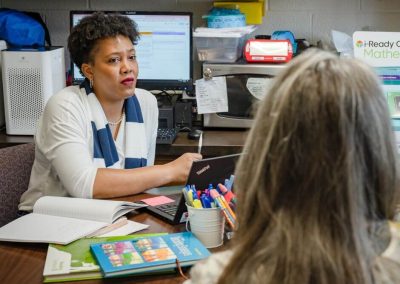Direct Instruction
We believe that if the child hasn’t learned, the teacher hasn’t taught properly. When teachers have effective tools, proper training, and ongoing support, they can prepare every child for success in college, career, and life.
COACHING
BCP coaches work one-on-one in the classroom to mentor teachers and model effective instruction. Once a week the BCP coaches meet to discuss student progress, teacher challenges, and overall school improvement.
PROFESSIONAL DEVELOPMENT CONFERENCES
BCP provides two professional development conferences and several day-long seminars for over 200 teachers each year. Principals determine their staff training needs and BCP customizes training to meet those needs. BCP also provides training to address areas identified by BCP coaches and leadership staff.
SUMMER TRAINING INSTITUTE
Each summer BCP holds a Summer Training Institute for new and returning teachers, which offers training in both behavior management and academic instruction.
Education fads come and go, but BCP focuses on identifying and implementing proven strategies. We have stayed true to our principles throughout the past two decades, where we have identified or created a variety of effective educational programs, put them into practice, and refined them as needed.

DIRECT INSTRUCTION
Direct Instruction is a research-based comprehensive school reform model that consists of carefully scripted lessons, backed by texts and workbooks. It is supported by over 40 years of research and has been consistently rated as one of the most effective comprehensive school reform models. When implemented properly, students attain reading, writing, and math skills beyond their current grade level in a relatively short amount of time. BCP brought Direct Instruction to Baltimore City Schools in 1996.
The Direct Instruction reading and language arts programs assess students every five to ten lessons to make sure they are on track. BCP leadership and school-based academic coaches meet weekly to review student data, determine where additional support may be needed, and identify opportunities for acceleration.
For more information visit the National Institute for Direction Instruction.
CORE KNOWLEDGE CURRICULUM
BCP piloted the Core Knowledge Language Arts curriculum in 2014, which ensures students are well prepared when they transition from learning to read to reading to learn. The curriculum includes fiction and nonfiction texts that teachers read aloud. These texts are grouped in knowledge domains that create interactive opportunities to question, discuss, and share ideas centered on text.
MAP TESTING
Northwest Evaluation Association (NWEA)’s Measures of Academic Progress (MAP) assessments are state-aligned computerized adaptive tests that accurately reflect the instructional level of each student and measure growth over time. BCP began using MAP to measure student growth at each BCP schools in 2007. MAP assessments are administered at least twice a year to measure and analyze student growth. For more information visit Northwest Evaluation Association.
Ready to Read Act
BCP is committed to identifying and addressing the needs of each student. To this end and in response to recent legislation from the Maryland General Assembly (Senate Bill 734, Ready to Read Act), all BCP schools will be using the MAP Reading Fluency with Dyslexia Screener as a literacy screener on all Kindergarten students to determine students’ foundational reading skills and to predict risk of future difficulties so that appropriate early intervention can take place. In addition, schools will screen any student in grades 1-3 who show some level of risk on their MAP Growth assessment, as well as those who are new and not previously screened. The screening occurs three times during the year: the beginning of the year (BOY); the middle of the year (MOY); and the end of the year (EOY). Parents will be notified by the school of their students’ results and any additional intervention support that is recommended.
Want to learn more? Download the Ready to Read Act (Senate Bill 734) or view COMAR 13A.13.08 on MSDE’s Website by clicking here.




